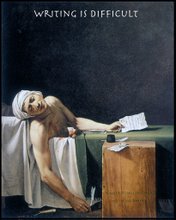
I do apologize for it being so confusing to most, and it was my number one worry and will definitely be worked on. I wrote this as if I was a video editor (well, I do that anyways) and some of the tricks and such that film makers use don't necessarily translate well to creative writing. Ah, only if I could use Photoshop, Motion, and Final Cut to make a peice of creative writing (seriously, that's how my mind worked when I wrote this thing, like using a movie timeline and running at 24fps.) This is what happens when you have English 210 and Media Arts 497g back to back each day.
So I propose this. Each of the "memories" he has (which are in 1st person, present tense... and will stay that way) are false ways that Joy dies, none of which are true. He only conjures up these visions in order to explore if her death in a different way would ease his heart (which it does not). In order to step into these "fake memories" (sorry, that's the best term I can come up with) I think I'll take Daniel's advice and have some more objects in real life make him think more about the scenes his sad little mind produces. Then, start to transition, like a "Dip-to-Black" transition (when the screen fades out then back in) and come back in black and white. I thought that the POV change was enough, but I can work on putting in more of "His mind started thinking wildly when he saw the children, making ideas and acusations, false logistics as to how his wife Joy could have turned to death. He thought these in hopes it would ease his heavy heart." Literally, I'll make him view the "fake memories" in black-and-white, the only thing he sees in color will be the actual death by car.
Will this work to make the difference of reality, and imaginary less confusing to the reader without having to state the fakeness outright?
(Again, can you tell I think behind a camera? Dang... been doing this stuff for far too long already.)
As for my character development, I would rather keep him from developing too much. He is to be "motionless" in this sense, showing how some people just can't fully get over it. As for the ending, I'll be changing that, having the knife that does not kill her be more pronounced and obvious so that we realize that he does not kill her, only held it as he ran outside.
I'm still struggling with him moving forward in his life. I don't really want him to move too far, and have him realize that thinking of other ways she could have died, will never bring her back, and never make the sadness go away. Only accepting it will allow him to move on. I dunno, it seemed really cool when I wrote it. Now, seems like a dark Film Noir script that doesn't go places.
[Thanks to Marissa for the cool drawing!]


4 comments:
Oh, Brewster, you are very most welcome.:)
Oh, also, I also don't want you to let him move forward, either. I think that's the whole point of the story, the fact that he has to accept his wife's death in order to do so.
Or maybe he does come to some new understanding of his wife's death, some sort of "peace" with it...but he still doesn't feel "better," you know? I think that this would be a very honest rendering of grief, that we think there is some moment at which we'll get to when we get to stop grieving, that grief can be quantified or "defeated," when in reality, it can't, on some levels.
I think the changes you mentioned would help make it less confusing. Like I said, I like the way it "flips in your mind" at the end, so I wouldn't want it to change too much.Just enough that I still know that the laws of physics are working.
Post a Comment